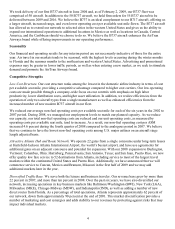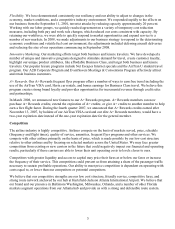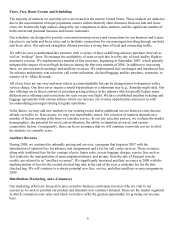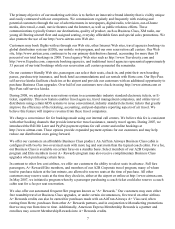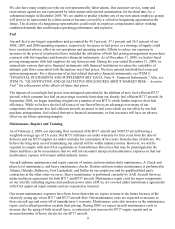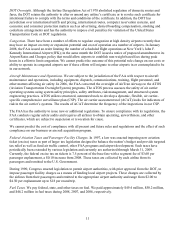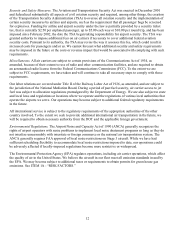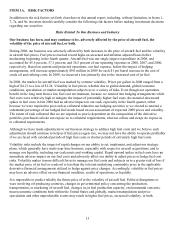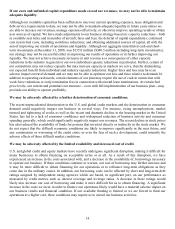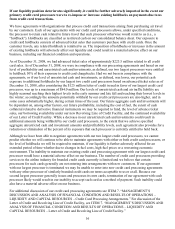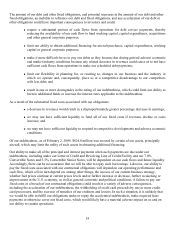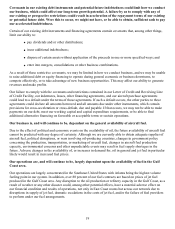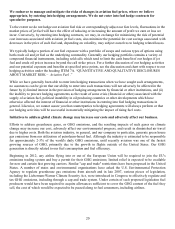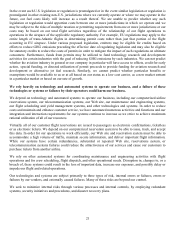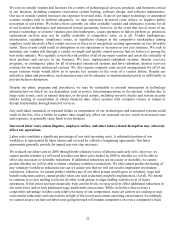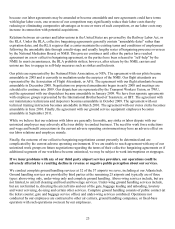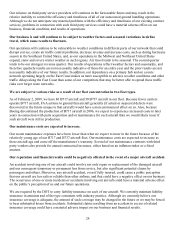Airtran 2008 Annual Report Download - page 22
Download and view the complete annual report
Please find page 22 of the 2008 Airtran annual report below. You can navigate through the pages in the report by either clicking on the pages listed below, or by using the keyword search tool below to find specific information within the annual report.If our costs and unfunded capital expenditure needs exceed our revenues, we may not be able to maintain
adequate liquidity.
Although our available capital has been sufficient to meet our current operating expenses, lease obligation and
debt service requirements to date, we may not be able to maintain adequate liquidity in future years unless we
are able to increase our revenues, manage expenses effectively, or otherwise improve operating results or obtain
new sources of capital. We have made adjustments to our business strategy based on: capacity reductions—both
in available seat miles and in number of aircraft; fares and fees; the deferral of capital expenditures; continued
cuts in non-fuel costs, including workforce reductions; and obtaining additional sources of capital, all with the
aim of improving our results of operations and liquidity. Although our aggregate unrestricted cash and short-
term investments at December 31, 2008, was $335.0 million ($340.5 million including long-term investments),
our strategy may not be successful either in improving our results of operations or in further improving our
liquidity. We may not achieve necessary increases in unit revenue as a consequence of either capacity
reductions in the industry in general or our own individual capacity reductions in particular. Further, certain of
our competitors may not reduce capacity but may increase capacity in markets we serve, thereby diminishing
our expected benefit from individual and industry capacity reductions. Higher fares and fees may have an
adverse impact on travel demand and we may not be able to optimize our fees and fares relative to demand. In
addition to operating cash needs, certain elements of our plan may require the use of cash in connection with
work force reductions or early termination fees in connection with aircraft lease terminations. At certain fuel
price levels, our current and potential cost structure—even with full implementation of our business plan—may
preclude our ability to operate profitably.
We may be adversely affected by a further deterioration of economic conditions.
The recent unprecedented deterioration in the U.S. and global credit markets and the deterioration in consumer
demand could negatively impact our business in several ways. For instance, rising unemployment, market
turmoil and tightening of credit, as well as the recent and dramatic decline in the housing market in the United
States, has led to a lack of consumer confidence and widespread reduction of business activity and consumer
spending generally, which could significantly negatively impact our revenues. The recent decline in stock prices
has also reduced the availability of funds for persons that invested directly or indirectly in the stock market. We
do not expect that the difficult economic conditions are likely to improve significantly in the near future, and
any continuation or worsening of the credit crisis, or even the fear of such a development, could intensify the
adverse effects of these difficult market conditions.
We may be adversely affected by the limited availability and increased cost of credit.
U.S. and global credit and equity markets have recently undergone significant disruption, making it difficult for
many businesses to obtain financing on acceptable terms or at all. As a result of this disruption, we have
experienced an increase in the costs associated with, and a decrease in the availability of, borrowings necessary
to operate our business. If these conditions continue or worsen, our cost of borrowing may further increase and
it may be more difficult to obtain financing for our operations or to refinance long-term obligations as they
come due in the ordinary course. In addition, our borrowing costs can be affected by short and long-term debt
ratings assigned by independent rating agencies which are based, in significant part, on our performance as
measured by credit metrics such as interest coverage and leverage ratios. A decrease in these ratings would
likely also increase our cost of borrowing and make it more difficult for us to obtain financing. A significant
increase in the costs we incur in order to finance our operations likely would have a material adverse impact on
our business results and financial condition. If our available funding is limited or we are forced to fund our
operations at a higher cost, these conditions may require us to curtail our business activities.
14


